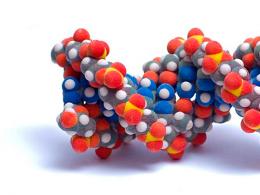What are amino acids for and how to take them. Amino acids: what they are, why they are needed in sports, how to take them. Why are amino acids needed in sports?
Not all athletes clearly understand what amino acids are needed for, and some may even get confused in the terminology. There is also still a lively debate about whether amino acids are needed or whether it is possible to limit ourselves to protein? In order not to create even more misconceptions, and also to summarize how important amino acids are in the form of a supplement, we will consider everything in as much detail as possible.
Why are amino acids needed?
What are amino acids? To describe their role as simply as possible, these are the substances that make up all the proteins in the body. Any protein that enters the body with food is broken down into amino acids during digestion, which are necessary for the functioning of all body systems and tissue renewal, therefore the question of their relevance and importance is initially incorrect. From this we can already draw a simple conclusion and understand why an athlete needs amino acids, since muscle mass, strength, speed and other characteristics are important in almost any discipline.
What benefits do amino acids provide? A more muscular body, less fat, better health and well-being. They are equally important for both children and the elderly, and even more so for those who play sports.

When playing sports, the body spends much more resources and also requires more nutrients for recovery, so the need for amino acids only increases. They contribute to:
- Gaining muscle mass;
- Fat burning;
- Slowing down catabolism;
- Increased strength indicators;
- Accelerate recovery.
Moreover, amino acids are needed simply so that the muscles can function properly, even while walking.

It is the question of choice that causes the most discussion and controversy, since many people and even athletes still do not fully understand the difference between protein and amino acids, considering them to be different supplements. Of course, this is not true and there is a lot in common between them. In fact, protein is the same set of amino acids that is present in the amino acid complex, but only with the condition that it is absorbed more slowly. Simply put, the difference between protein and amino acids is only in the speed of their absorption. If in bodybuilding and other strength sports the rate of absorption plays an extremely important role and amino acids still have an advantage, then in other sports this is just an unnecessary financial waste. It is no secret that amino acid complexes are much more expensive than even the highest quality protein, and most manufacturers offer small portions, which clearly shows that amino acids should be taken only in the most important cases, namely in the morning and after/during training. Another very dubious advantage of amino acids is that they usually lack fat, carbohydrates, and are free of lactose, although any high-quality protein can “boast” of this.
By drinking a regular protein shake, after the protein is broken down into smaller compounds (aka amino acids), you'll get the same benefits as a supplement, but for much less. If we talk about really useful and necessary amino acid complexes, then BCAA will be the undisputed leader. This supplement consists of three branched chain amino acids (Leucine, Isoleucine, Valine), which play a direct role in the formation of muscle tissue. It allows you to speed up protein synthesis, improve weight gain, strength, fat burning, and also block catabolic processes.
From this we can draw a simple conclusion that BCAA are as necessary as protein, not only for athletes, but for all people. At the same time, simultaneous intake of protein and amino acids will be extremely illogical, since such a scheme will deprive amino acids of their main advantage - the speed of absorption.
Amino acids are a fairly convenient thing that we recommend including in your sports kit, if only because they allow muscles to quickly recover after training and protect them during the “fasting” period. Whether to buy protein along with them is your decision, but it is not at all necessary to do this if you take an amino acid complex and BCAA.
Hi all. In today’s article we will look at another supplement that you can easily buy at any sports nutrition store.
Today we will talk about amino acids. For muscle growth, this is one of the most important supplements. Proteins are built from amino acids, which is especially important in bodybuilding. After all, muscles are practically nothing but proteins, that is, amino acids. The body uses them for its growth, strengthening, and restoration.
Purposes of taking amino acids
Amino acids are necessary for:
- increasing the effectiveness of training and accelerating muscle building;
- reduction of post-workout muscle pain and rapid recovery;
- enriching nutrition with complete protein;
- suppressing appetite and burning some unnecessary fat.
It is very useful to know that one of the functions of amino acids is “fat burning” (more energy is spent on the digestion of proteins, therefore, more calories are spent during the digestion of amino acids), so if someone wants to use amino acids for weight loss, then this is very useful good supplement.
Advantages of amino acids
Clear advantages of amino acid complexes:
- low calorie content;
- perfectly complement a protein diet aimed at burning fat and developing muscle definition;
- do not allow catabolic destruction of muscle tissue (prevent “burning out”, in addition to fat, part of the muscles).
Their disadvantages
High price and small doses. If there are no financial difficulties, you can take 10 g of amino acids four times a day with a guaranteed excellent result in gaining muscle mass. But almost the same effect will be obtained from taking 20 g of protein four times a day. But it's cheaper.
Types of amino acids
Amino acids for sports nutrition are available in two types:
- hydrolysates,
- free amino acids.
Hydrolyzate is protein broken down to the level of free amino acids. It is distinguished from protein by instant absorption with minimal digestion time, which ensures a rapid supply of amino acids for muscle growth.
Products with free amino acids are characterized by the maximum speed of their transport. Often these are isolated substances (glycine, arginine, glutamine, etc.), but complex compounds are also found.
Both types of complexes give good results. Their difference is that hydrolysates are of more natural origin, and free amino acids, as a rule, are a synthetic product.
There is also a division of amino acids into groups:
- replaceable,
- irreplaceable.
 From the point of view of muscle growth, essential amino acids are the most important. They are not synthesized by the human body, so they must be obtained from protein foods - meat, dairy products, eggs and especially soy.
From the point of view of muscle growth, essential amino acids are the most important. They are not synthesized by the human body, so they must be obtained from protein foods - meat, dairy products, eggs and especially soy.
When choosing amino acids for yourself, you need to look at the original raw materials. The presence of low-value wheat protein or collagen will lower the price of the drug, but will worsen its composition and effectiveness.
Essential amino acids, especially BCAAs, kickstart anabolic growth processes. The more of them in a product, the better. Athletes sometimes choose pure BCAAs - it’s a little more expensive, but the results are excellent. BCAA contains three amino acids:
- Valin,
- Isoleucine,
- Leucine.
Other essential amino acids:
- Tryptophan
- Histidine
- Lysine
- Phenylalanine
- Methionine
- Threonine
Hydrolysates based on whey protein or egg white, which are the most valuable sources of essential amino acids, are highly effective. Thus, the amino acid complexes AMINO LIQUID and AMINO 2500 from the Performance company are created on the basis of whey hydrolyzate.
Taking amino acids
Amino acid release forms of equivalent effectiveness:
- powders,
- pills,
- solutions,
- capsules,
- injections.
Intravenous injections of amino acids have no advantages over other forms, but are fraught with complications and side effects. Therefore, it is better not to resort to them.
Time of receipt
It depends on the purpose of taking amino acids.
To gain muscle mass, it is best to take them only before and after training, as well as in the morning. These are the moments at which amino acids are required at a high rate. At other times, it is more beneficial to consume protein.
For the purpose of losing weight, amino acids are taken more often.
Dosage
In bodybuilding, amino acids are taken in a wide range of dosages. A single dose should not be less than 5 g. In this case, the maximum effect is achieved with a single dose of 10-20 g.
When purchasing an amino acid complex, you should not lose sight of the dose size. Sometimes manufacturers reduce doses, increasing the cost per unit weight of the product.
Diverse and so that you don’t get lost in all this diversity, we have compiled a special table for you.
Do you want beautiful abs? Then our exercises, which are here, will help you achieve this.
Compatibility and side effects
Amino acids can be combined with any sports nutrition. But taking them at the same time is not always good. The rate of absorption of amino acid complexes is inhibited if the following are used with them:
- protein,
- gainer,
- meal replacements,
You should carefully read the manufacturer's advice.
Amino acids have no side effects because they are natural food components. The duration of amino acid consumption is not limited. Also, no cycling or breaks are required.
How to check quality
This is not at all difficult to do:
- Powdered amino acids are soluble in water (except BCAA).
- They have a bitter taste.
- The consistency and color correspond to what is written on the label.
- Packaging that is properly sealed and meets factory standards.
- Checking the expiration date.
Amino acids serve as the main material for the construction of muscle tissue. They are also actively involved in all the most important processes of the body. But their main value is ensuring muscle growth. Therefore, the use of amino acids alone or in complexes is extremely important in bodybuilding.
Every person who is seriously interested in sports cannot do without theoretical knowledge in the field of their own physiology. After all, in order to pump up muscles, it is important not only to lift iron, but also to know why amino acids are needed, how to properly organize nutrition and training regimen, and most importantly, how to train without harm to the body.
Why do athletes need amino acids?Every advanced athlete knows why amino acids are needed in bodybuilding. If you don't already know, be sure to pay attention to this area.
Amino acids are a special chemical compound from the category of organic acids. Unlike fats and carbohydrates, they are 16% nitrogen. Each molecule of such substances contains one or more amino groups. When they are processed in the gastrointestinal tract, protein synthesis occurs, which is used in the construction of muscles, as well as the production of other compounds that are necessary for the body. To summarize the above, amino acids are the material for building muscles.
In addition, amino acids are necessary for healthy mental and physical tone of the body after training. They are also involved in the process of fat burning, the functioning of the entire nervous system and even the brain. Why does the body need amino acids? To maintain the whole balance. And they help the athlete build muscle mass more effectively and recover more easily even after heavy overload.
Amino acids: what are they and what are they for?About 20 amino acids are known, which are divided into three classes: nonessential acids (the human body is able to synthesize them itself), partially nonessential (the body produces them itself from other acids), and essential (a person can only get them from food, they are not produced in the body ).
Essential amino acids include:
- aspartic acid (necessary for the absorption of minerals);
- glutamic acid (reduces cravings for sweets and alcohol);
- ornithine (needed for the production of growth hormone);
- glycine (needed for brain activity);
- serine (participates in cell renewal);
- taurine (helps absorb fat);
- proline (needed in the treatment of injuries);
- glutamine (energy source);
- cystine (antioxidant);
- Alanine (energy source).
Let's look at the middle category, which includes partially essential amino acids, and find out what they are needed for. This group includes the important arginine, cysteine and tyrosine, which help develop muscles and improve immunity. L-arginine creates a cheerful mood, and, like many other acids in this group, is a powerful antidepressant.
There are also essential amino acids that need to be taken regularly, since they cannot be absorbed into the body through other routes. These include:

The daily human need for each of these acids is about 1 g, but this number varies based on the weight, gender and age of the person.
When should you take amino acids?If you do not follow a balanced diet, then you need amino acids in any case. Every athlete needs them, because his body spends a lot of resources recovering from heavy physical exertion.
There are two groups of substances in nature: organic and inorganic. The latter include compounds such as hydrocarbons, alkynes, alkenes, alcohols, lipids, nucleic and other acids, proteins, carbohydrates, amino acids. We will tell you why these substances are needed in this article. All of them certainly contain carbon and hydrogen atoms. They may also contain oxygen, sulfur, nitrogen and other elements. The science that studies proteins, acids, oxides, amino acids is chemistry. She explores the properties and characteristics of each group of substances.
Amino acids - what are these substances for?
They are very important for the body of any living creature on the planet, as they are a component of the most important substances - proteins. There are a total of twenty-one amino acids from which these compounds are formed. Each contains atoms of hydrogen, nitrogen, carbon and oxygen. The chemical structure of these substances has an amino group NH2, from which the name comes.
How are proteins made from amino acids?
These organic substances are formed in four stages, their structure consists of primary, secondary, tertiary and quaternary structures. Each of them determines certain properties of the protein. Primary determines the number and order of placement of amino acids found in the polypeptide chain. The secondary is an alpha helix or beta structure. The first are formed due to the twisting of the polypeptide chain and the appearance within one.

The second is due to the occurrence of bonds between groups of atoms of different polypeptide chains. The tertiary structure is interconnected alpha helices and beta structures. It can be of two types: fibrillar and globular. The first is a long thread. Proteins with this structure are fibrin, myosin, found in muscle tissue, as well as others. The second has the form of a ball, which includes, for example, insulin, hemoglobin and many others. In the body of living beings, special cell organelles - ribosomes - are responsible for the synthesis of proteins from amino acids. Information about the proteins that need to be produced is encoded in DNA and transferred to ribosomes using RNA.
What are the types of amino acids?
There are only twenty-one compounds from which proteins are formed in nature. The human body is able to synthesize some of them during metabolism (metabolism), while others cannot. In general, the following amino acids exist in nature: histidine, valine, lysine, isoleucine, leucine, threonine, methionine, phenylalanine, tryptophan, cysteine, tyrosine, arginine, alanine, glutamine, asparagine, glycine, proline, carnitine, ornithine, taurine, serine. The first nine amino acids listed above are essential. There are also conditionally essential ones - those that the body can use instead of essential ones in extreme cases. These are, for example, tyrosine and cysteine. The first can be used instead of phenylalanine, and the second - if methionine is not available. Essential amino acids in foods are a prerequisite for a healthy diet.
What foods do they contain?

All other amino acids may not be contained in foods consumed by humans, since the body is capable of producing them on its own, but it is still desirable that some of them be supplied with food. Most of the non-essential amino acids are found in the same foods as the essential ones, that is, meat, fish, milk - those foods that are rich in protein.
The role of each amino acid in the human body
Each of these substances performs a specific function in the body. The most necessary amino acids for full life are the essential ones, so it is very important to consume foods containing them in sufficient quantities.

Since the main building material for our body is protein, we can say that the most important and necessary substances are amino acids. We will now tell you why we need irreplaceable ones. As already written above, this group of amino acids includes histidine, valine, leucine, isoleucine, threonine, methionine, phenylalanine, tryptophan. Each of these chemical compounds plays its own specific role in the body. Thus, valine is necessary for full growth, so foods high in it must be contained in sufficient quantities in the diet of children, adolescents and athletes who need to increase the concentration of muscle mass. Histidine also plays an important role - it participates in the process of tissue regeneration and is part of hemoglobin (which is why, if its content in the blood is low, it is recommended to increase the amount of buckwheat porridge consumed). The body needs leucine in order to synthesize proteins, as well as to maintain the activity of the immune system at the proper level.

Lysine - without this substance, calcium simply will not be absorbed in the body, so you cannot allow a shortage of this amino acid - you need to include more fish, cheese and other dairy products in your diet. Tryptophan is needed to produce vitamin B, as well as hormones that regulate hunger and mood. This substance is part of drugs that help calm and eliminate insomnia. Phenylalanine is used by the body to produce hormones such as tyrosine and adrenaline. This substance can also be included in medications prescribed for insomnia or depression.
Amino acids from a chemical point of view
You already know that the components of proteins and vital substances for humans are amino acids. We have already looked at what these compounds are needed for, now let’s move on to their chemical properties.
Chemical properties of amino acids
Each of them is a little individual, although they have common features. Since the composition of amino acids can be different and include different chemical elements, the properties will be slightly different. A common feature for all substances in this group is the ability to condense to form peptides. Amino acids can also react to form hydroxy acids, water and nitrogen.

In addition, they interact with alcohols. In this case, a hydrochloride salt of an ether and water are formed. For such a reaction, the presence of a catalyst in a gaseous aggregate state is necessary.
How to detect their presence?
To determine the presence of these substances, there are special amino acids. For example, to detect cysteine, you need to add lead acetate, and use heat and an alkaline environment. In this case, lead sulfide should form, which precipitates as a black precipitate. Also, the amount of amino acid in a solution can be determined by adding nitrous acid to it. This can be recognized by the volume of nitrogen released.
Amino acids are elements found in food proteins. They enter the human body through regular food (meat, cottage cheese, eggs, etc.). When protein enters the digestive tract, under the influence of various enzymes it begins to break down and turn into amino acids. These beneficial substances penetrate the blood and nourish muscles, tissues and all organs in general.
Amino acids in sports nutrition are natural supplements that can be taken without any restrictions. Essential amino acids are not produced in the body, so it is extremely important to obtain them from food or as a sports supplement.
Beneficial properties of amino acids
Amino acids sold as supplements in sports nutrition stores are absorbed much faster than those found in food. This is extremely important for athletes, as they need to recover quickly, increase muscle mass and constantly replenish their muscles with useful substances. All these processes are provided by amino acids.
It is much more convenient to take a portion of ready-made amino acids before training than to eat a large amount of meat, cottage cheese, etc. Essential amino acids with branched side chains, sold in sports nutrition stores under the name BCAA, have gained great popularity.
BCAAs are 3 main amino acids (valine, isoleucine and leucine). They are very useful not only for athletes who want to avoid catabolic processes and maintain their muscles even during low-calorie diets. BCAAs will help you recover from injuries, flu and inflammatory diseases.
Side effects of amino acids
Taking amino acids in the form of a sports supplement is the same as eating meat, egg whites, etc., only much healthier. Therefore, the side effects of amino acids are fiction; they do not exist in nature.
Amino acid complexes for professional athletes are obtained from whey protein, i.e. made from natural protein extracted from cow's milk. But it is worth knowing that an amino acid such as glycine has a calming effect on a person; it reduces feelings of fear, anxiety and reduces psycho-emotional stress. If an athlete is not against such influence, then he has nothing to fear.
Amino acid complexes bring only benefits to the human body, but not everyone can afford them, since their cost is quite high.






